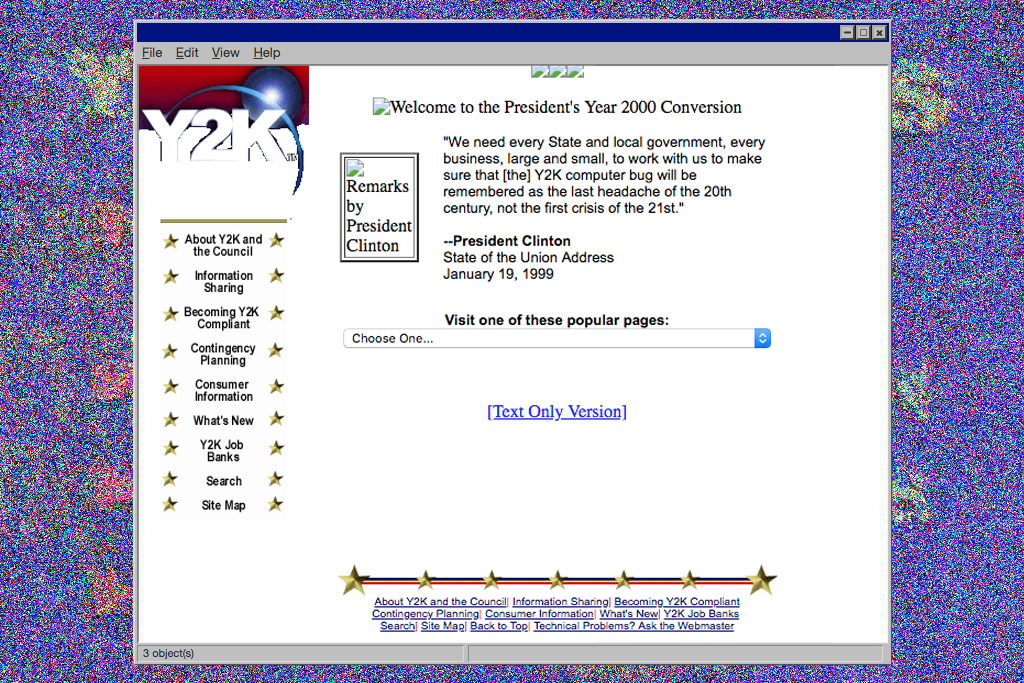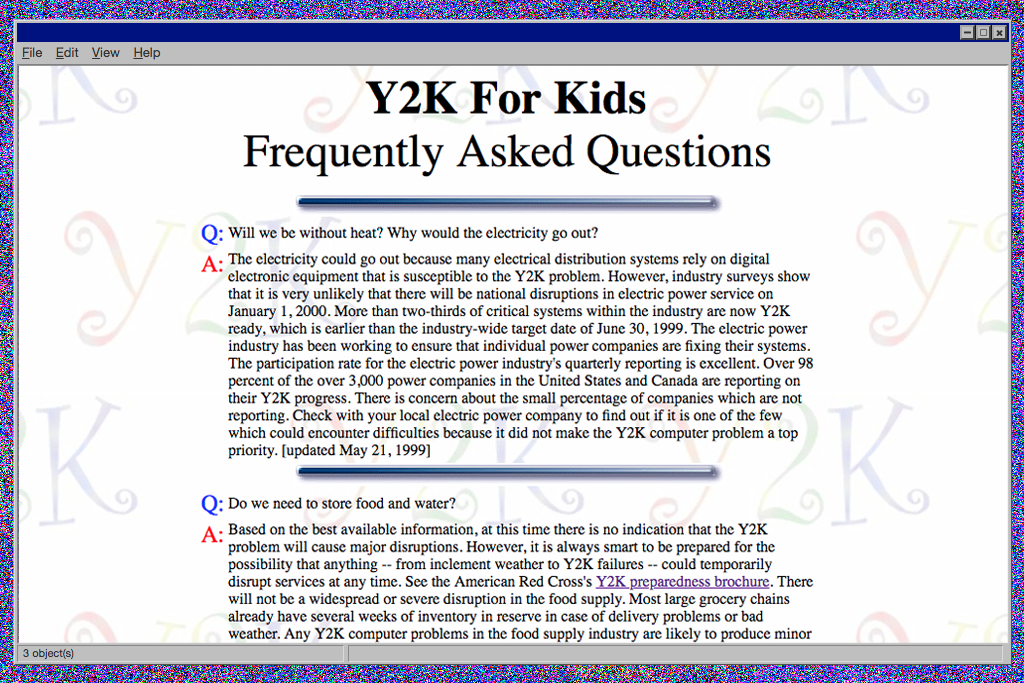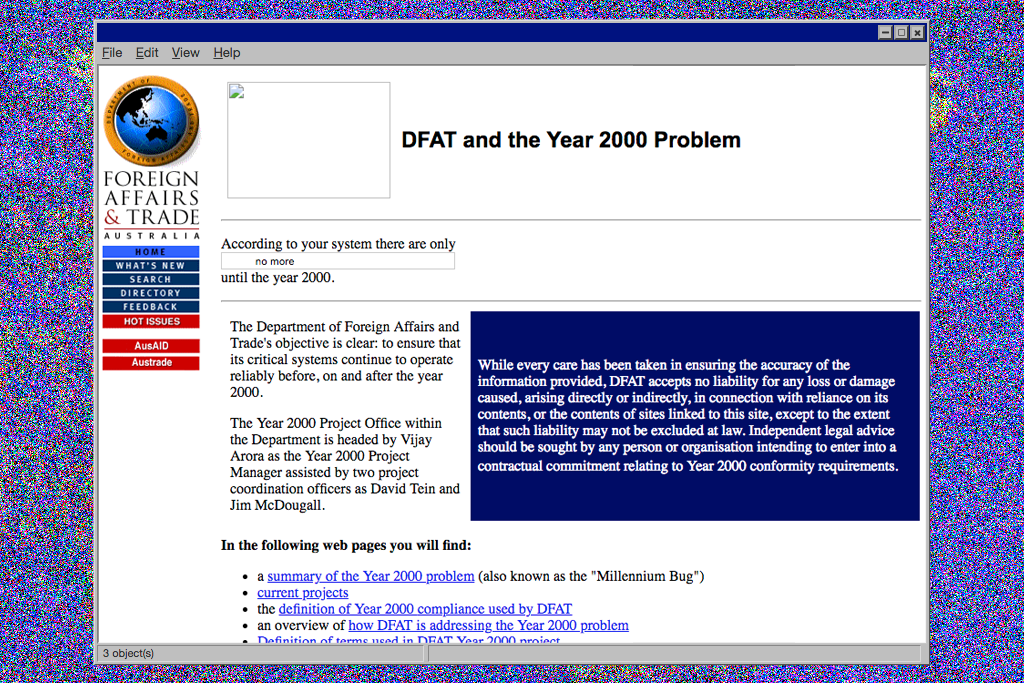Break The Internet: Remembering That Time Y2K Threatened To Kill Us All
As the new millennium approached, a lot of people thought the end was nigh thanks to a computer bug.

There were a few ways things could have gone wrong at midnight on January 1, 2000, depending on who you asked.
Some people feared the worst: that a computer bug known as Y2K would launch nuclear missiles and cause planes to fall from the sky. Other people insisted that this thing called Y2K was a hoax, not worthy of a second thought. Still others hedged their bets, packing go-bags with dehydrated food and wilderness survival supplies. Governments around the world spent the equivalent of $USD448 billion in today’s money to counter the impending threat. And at the stroke of midnight on January 1, 2000, here’s what happened: not much.
If you hail from the tail end of the millennial generation, like me, you might not remember this happening (or rather, not happening). It reads like the plot of a bad sci-fi film: Vague-Yet-Menacing Computer Bug threatens to take down everything in its path, unless someone can find a way to defeat it before the clock strikes midnight.
“It reads like the plot of a bad sci-fi film: Vague-Yet-Menacing Computer Bug threatens to take down everything in its path, unless someone can find a way to defeat it before the clock strikes midnight.”
Y2K is not a sci-fi film, though, because it did actually happen. It’s just that not a lot happened, and that meant that every side claimed victory: Y2K deniers crowed that they’d been right all along, Y2K whistleblowers claimed they’d helped avert disaster, and the less tech-savvy members of the public just chucked their wilderness survival kits under the bed and forgot about the whole thing.
Was it all just a hoax, or was Y2K the most successfully averted disaster in recent memory? What does Y2K even mean? Twenty years on, here’s the lowdown.
WTF Is Y2K?
Let’s start with the basics: Y2K is short for “year two thousand” (“k” as in “kilo” as in “thousand”). It was also known as the Millennium Bug or the Year 2000 Problem.
Here’s why the year 2000 was such a problem. Back when computers were just getting started, storage was really expensive. To save room, programmers wrote years in two digits rather than four: 1978 becomes 78, 1999 becomes 99. That meant that the year 2000 was an issue, though, because “00” could just as easily mean 1900. To a computer, the stroke of midnight on January 1 2000 might appear like a jump backwards in time. Or forwards, to 19100, if the computer program in question calculated dates by adding 19 to the front of the abbreviated year.
However you sliced it, quite a few older computer programs were simply unprepared for the year 2000. And if you’re thinking “big deal, your calendar’s wrong”, then you’re misunderstanding just how much a date can do.
Again, this depends on how a particular program was written. Some programs might have just kept running, albeit with the wrong date, causing scheduling issues or data loss. Other programs might have registered the weird date as an error and partially (or totally) stopped working. And because so many programs use dates at some point (consider that saving and retrieving files of any kind typically involves dates), almost anything involving a computer was potentially vulnerable to Y2K: personal computers, sure, but also government ones, banking and transportation systems, the military, you name it.
There’s more nuance to it than that, but that’s the gist. Hence the global panic as the millennium neared its end.
Falling Planes And Nuclear War: People Really, Really Worried About Y2K
Looking back on it from 2019, it’s hard to imagine Y2K inspiring a sense of urgency in ordinary people. We live in a time when computer bugs and glitches, even serious ones, occur regularly and subside from the news cycle just as quickly.
1999, though, was a different time, and remnants of that time still exist on the internet. From 1998 onwards, the US government maintained a specialised website (Y2K.gov) dedicated to educating people about the bug. The page has been defunct for years, but in 1999 it was the picture of a cutting-edge homepage. “Welcome to the President’s Year 2000 Conversion”, it announced, next to a custom Y2K logo, complete with bevelled text and lens flare, which made it looks a little like the looming problem of Y2K was about to eclipse the sun.

The US government’s Y2K website as it appeared in 1999.
The website opened with a solemn quote from Bill Clinton’s 1999 State of the Union speech, where he said that “we need every state and local government, every business, large and small, to work with us to make sure that [the] Y2K computer bug will be remembered as the last headache of the 20th century, not the first crisis of the 21st.”
On another page, titled “Y2K For Kids”, a cheerful rainbow background helped reassure young people that Y2K “will not blow up your computer” or “cause serious damage in your community”. The page also included an FAQ, which answered questions like “do we need to store food and water?” (Answer: “It is always smart to be prepared for the possibility that anything — from inclement weather to Y2K failures — could temporarily disrupt services at any time”), “should my parents take their money out of the bank?” (Answer: “No”), “are nuclear missiles affected by Y2K? Will they launch?” (Answer: “Computers by themselves cannot launch nuclear weapons”) and “will my VCR work?” (probably, depending on the model).

This is what government web design looked like in 1999.
Back on the Y2K For Adults section of the website, there was also a page dedicated solely to debunking rumours, including that the President planned on declaring a state of martial law to address Y2K, that Y2K would cause federal prison doors to open at the stroke of midnight on January 1 2000, that lifts and elevators would freeze or fall due to Y2K, and that the turn of the millennium would cause pacemakers to malfunction, killing people where they stood. The page linked to the American Red Cross website, which urged people to err on the safe side and prepare for Y2K as they would for a large storm, stocking food and medical supplies, some extra cash, a full tank of petrol, and warm clothes.
In other words, people really did take Y2K seriously. Deadly seriously. In fact, maybe the best way to illustrate how much people cared is with this stat: on New Year’s Eve in 1999, the Australian government’s Y2K website was getting around 800,000 hits an hour. This is in 1999, when you needed a hulking big computer connected to the internet with actual wires if you wanted to surf the web.
That’s a whole lot of people spending their New Year’s Eve with the Australian Government on the World Wide Web. And for what?

The Australian government’s comparatively boring Y2K website.
What Actually Happened On January 1, 2000?
When you compare it to people’s worst fears of simultaneous nuclear missile launches and planetary destruction, what actually happened on January 1, 2000 was pretty tame.
Things did happen, though. In Japan, two nuclear power plants experienced (thankfully) minor faults. The pokies broke down in Delaware. Around the world, some flights were delayed. Quite a few websites listed the date as 01/01/19100 (talk about being on the cutting edge). And in Australia, bus ticket machines broke down in South Australia and Tasmania (nothing out of the ordinary, really).
The way governments told it, this was a success: the billions spent on averting crisis had, indeed, averted a crisis. As anyone who worked in tech at the time will tell you, this is correct.
But governments at the time didn’t broadcast their most serious concerns about Y2K, so as not to stoke panic (in fact, it was only a few weeks ago that files containing the Australian government’s pretty serious concerns — and desperate scramble to fix them — were declassified). And so when 2000 came and went unscathed, the people had a fair few opinions on whether those billions of dollars of taxpayer funds spent were actually worth it.
Needless to say, opinions differed. In January 2000, the BBC asked readers to write in with their takes on the situation. One reader, Judith Patten, reported that she’d had no problems with Y2K, but that the end of British daylight savings time had broken her alarm clock. She informed readers that she’d already tried taking the clock to the USA, placing it in a cast iron pot, and other remedies, and begged for advice.

Thanks for letting us know, Judith.
From those who stuck to the topic at hand, there was a range of responses. On the one hand, people like John Marshall from Australia felt confident asserting that “the Y2K scare was definitely a scare campaign — for reasons best known to the computer programmers and software manufacturers — this money could well have been spent to greater benefit to mankind the world over”.
At the other end of the spectrum, people remained panicked. “Please be reminded that there are still 12 months left in this year,” B Alexander (from the USA) wrote. “At work some horror stories were shared concerning bank statements and credit card problems…let us therefore watch the upcoming month very carefully”.
“Enter the 2038 problem: the end of (Unix) time. Much like Y2K, this one’s caused by early computer programmers lacking the foresight to see just how long computers would be sticking around for.”
Mostly, though, people seemed to find the middle ground, and concluded that the money spent on Y2K was justified because it helped avoid the biggest problems. “It’s the same as going to your doctor due to a stomach ache and complaining that it has gone away after treatment!” Frank Bradshaw (UK) wrote. “What was the media expecting? A fix and a meltdown? You can’t have both!”
Or as Roy Chapman (UK/Germany) put it, “Get real guys. Had there been a total meltdown, global thermonuclear war and all the other things that many seem to be actually looking forward to, just who would you have blamed? Exactly, the same poor souls who you are now blaming for the absence of these things.”
Strap In, Because The Next Y2K Is Coming
So no, Y2K was not a hoax, though it’s hard to say with certainty exactly which dire consequences we managed to avoid. It’s important to remember that we did avoid them, though, because the next Y2K is on its way.
Enter the 2038 problem: the end of (Unix) time. Much like Y2K, this one’s caused by early computer programmers lacking the foresight to see just how long computers would be sticking around for. Basically, computers based on a system called Unix (all Apple computers, for example) store time as the number of seconds that have passed since 1970: in 2038, space to store those seconds will run out.
A more pressing problem of a similar kind is climate change. In a way not too dissimilar to Y2K, time is running out. Just like with Y2K, the solution will involve billions of dollars invested, urgently, in fixes. And just like with Y2K, success will be underwhelming — in the best case scenario, not much will change.
For the sake of all of us, I hope that in twenty years’ time someone’s writing an explanation of why yes, governments really did have to spend those billions on climate change. The alternative is better left to the imagination.
All this week, Junkee is heading back in time to relive the greatest moments in pop culture from 1999. For more 1999 content, head here.

